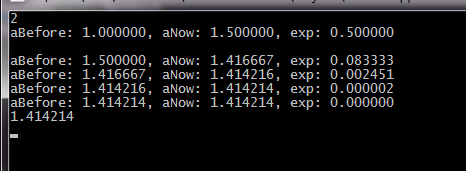4.1正数的n的平方根可以通过:
ai+1= (ai + n / ai ) / 2
得到,第一个a1是1,结果会越来越精确。
#include <stdio.h>int main()
{double input;double exp;scanf_s("%lf", &input);double aBefore = 1;double aNow = (aBefore + input / aBefore) / 2;exp = aBefore - aNow;exp = exp < 0 ? -exp : exp;printf("aBefore: %lf, aNow: %lf, exp: %f\n\n", aBefore, aNow, exp);while (exp > 0.000001) {aBefore = aNow;aNow = (aBefore + input / aBefore) / 2;exp = aBefore - aNow;exp = exp < 0 ? -exp : exp;printf("aBefore: %lf, aNow: %lf, exp: %lf\n", aBefore, aNow, exp);}return 0;
}

4.2 打印100以内的质数
因为2* 50 和 50 *2一样,如果按照1 2 3 4 一直遍历到目标的数其实有很多重复,事实上只需要计算到这个数的平方根即可停止。
#include <stdio.h>
#include <math.h>#define TRUE 1
#define FALSE 0int isPrimer(int num)
{int idx;int end = floor(sqrt(num)) + 1;for (idx = 2; idx <= end ; idx++){if (num % idx == 0) {return FALSE;}}return TRUE;
}
int main()
{int num;for (num = 1; num <= 100; num++){if (isPrimer(num)) {printf("%d ", num);}}return 0;
}

4.7去除字符串中多余的空格
#include <stdio.h>void trim(char str[])
{//判断之前是否在空格中int inEmpty = 0;//字符串下标int idx = 0;//循环字符串while (str[idx] != '\0') {//遇到空格if (str[idx] == ' ' || str[idx] == '\t' || str[idx] == '\n') {//如果之前不是空格,设置空格状态为1if (!inEmpty) {inEmpty = 1;idx++;}else{//如果之前是空格将之后的字符全部前移一位int len = strlen(str);for (int movStart = idx; movStart <= len; movStart++) {str[movStart] = str[movStart + 1];}}}else {//没遇到空格需要恢复非空格状态inEmpty = 0;idx++;}}
}int main()
{char name[] = " this is my name";printf("%s\n", name);trim(name);printf("%s\n", name);return 0;
}







)












-MBean)